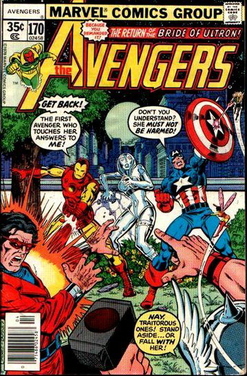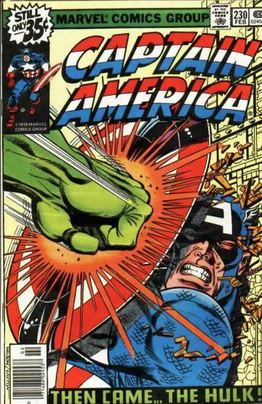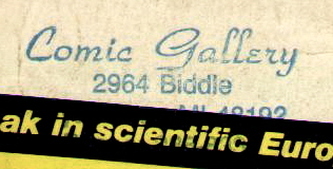_A Comic Shop Opens in My Old Hometown
by Rob Imes
A new comics shop is opening in my old hometown (Trenton, Michigan) in February, as recently reported here. This is amazing news, since there has never been a comics shop in my hometown (that I'm aware of). What's even more amazing is where it will be located.
I had recently posted on my Facebook wall that I was surprised when visiting West Grange Drugs a few weeks ago that they had the new issues of Ellery Queen's and Alfred Hitchcock's Mystery Magazines (and last month's issue of Asimov's Science Fiction) on their magazine shelves.

_ West Grange Drugs
(so named for the intersection of streets on which the strip mall sits, in which the drugstore resides) opened in the late 1950s, and was located for its
first twenty years at 3420 West Road, next to Wrigley's Supermarket. I
remember where the comics were located at the original drugstore, even
though I was only seven years old at the time. As soon as you walked
in, the magazines and comics were located to the right, near the
entrance. I believe that in February 1978 I bought Avengers
#170 here, which was the first issue of that series I'd ever bought --
and which I then bought regularly for the next six years.
By May 1979, West Grange Drugs had moved a few doors down to 3390 West Road, taking up a larger space in the strip mall that Wrigley's had vacated. (I know it was by May 1979 because I definitely remember that I bought Micronauts #8 in the new location, which came out that month.) Despite the larger space, West Grange Drugs stopped selling comicbooks by 1981, after which I bought most of my new comics from the local convenience stores Lawson's (renamed Dairy Mart in 1987 and closed in 1989) and 7-11.
By May 1979, West Grange Drugs had moved a few doors down to 3390 West Road, taking up a larger space in the strip mall that Wrigley's had vacated. (I know it was by May 1979 because I definitely remember that I bought Micronauts #8 in the new location, which came out that month.) Despite the larger space, West Grange Drugs stopped selling comicbooks by 1981, after which I bought most of my new comics from the local convenience stores Lawson's (renamed Dairy Mart in 1987 and closed in 1989) and 7-11.
_ After the move to 3390
West Road in 1979, the drugstore's previous address was sectioned into
two halves (3410 and 3420 West Road) to accomodate smaller storefronts.
The new comics shop will be at 3410 West. This is the same spot, the
right-half side of the old drugstore, where I bought Avengers #170 when I was seven!
The strip mall at West & Grange roads is a small one but I always
viewed it as the main shopping district of the "new" part of town. It
was designed to be that way. Before World War Two, the center of town
was located on the other side of the train tracks, near the river. My
mom would call that area "downtown Trenton," while some still call it
"old Trenton" because it dates back to the mid-1800s. (Some of the
still-standing houses were built in the late 1880s.)
After World War Two, the town expanded beyond "old Trenton," as areas
formerly consisting of farmland and meadows were bought up and turned
into suburban homes for new families; schools were built for the
children in those families to be educated, churches for those families
to worship, and stores for those familes to shop. This all happened
very quickly in the 1950s. In April 1951, a local newspaper noted: "Planned is a super-market and other shopping facilities at the north-east corner of Grange and West Roads." A May 1951 paper wrote: "Approximately
73 acres at the northeast corner of Grange and West Roads will be
transformed into nearly 400 new homes designed for working families.
Frontage of about 600 feet on West Road and about 1300 feet along the
east side of Grange Road of the Richard R. Newman farm will be platted
and prepared for construction of homes selling under $10,000. ....
Newman, who lives at 3248 West Road, bought the property in 1915 for
farming purposes. The subdivision will be served by large, deep sewers,
now under construction, village water, lights, streets and curbs, and
all village services." A 1952 Detroit Free Press article made mention of the town's development, referring to "the open country out on West Road" and that "the pleasant meadows west of Fort Street are giving way to rows of comfortable homes."
New streets were created for these subdivisions, and the first street
to be built east of the West-Grange strip mall was named Newman, after
the farmer Richard R. Newman who "bought the property in 1915." This
fact has long been forgotten, however, even by those who know the town
well and have lived there all their lives, as time has a way of erasing
from the record those who belonged to a past that we never knew and can
scarcely imagine.
The suburban home where I grew up was part of the town's rapid
development in the mid-1950s, where "pleasant meadows" and "open
country" were turned into subdivisions of newly-built ranch-style homes
to accomodate the baby-boom taking place. West Grange Drugs was a
20-minute walk from my home, faster on bicycle and the first place to
"go to" as a kid, once one was old enough to ride one's bike away from
home to go somewhere else to buy things. For me, such things to be
bought there included Star Wars trading cards and, of course, comic books. I
recall being at that strip mall when some friends told me that Action Comics
#500 had been released... a huge number, bigger than any comic had ever
reached before (that I knew about anyway). I was eight years old, the
same age that my father had been when the first issue had come out --
which showed me how much history these things had, how important they
were, and how they provided continuity with those who came before us.

_ There were other
stores in the strip mall. On the corner was the old-fashioned barber
shop where my dad got his hair cut, as I did at first. Later, during my
teen years, I got it cut at the salon located in the strip mall. Our
family would sometimes eat at Shong Hey, the Chinese restaurant located
there, too (still in business there, still has the best egg rolls).
There was the Sherwin-Williams paint store in the strip mall, which I
didn't go to, but when I was around ten years old, I noticed they had a
copy of Captain America #230
(cover showing the Hulk's fist hitting Cap's shield) inside the store,
laying with some other comics on a table, intended to occupy kids while
their parents shopped in the store. I needed that issue for my
collection (it had come out around a year before) and I finally worked
up the nerve to go inside and ask them if I could buy the comic from
them. As I wrote on my Facebook wall a couple years ago (during my
"history of collecting Cap" series of posts): "I can't remember what
they said (perhaps they gave it to me for free), but that well-read copy
of #230 remains in my collection to this day."
As noted earlier, West Grange Drugs had stopped selling comics by 1981. My suspicion was that they didn't like kids hanging around in the store and so a good way to get rid of them was to get rid of the comics spinner rack. There were still things to buy there, including comics in magazine format like Mad and Crazy. One day in 1981, when I was ten years old, my next door neighbor Andy was talking about a Mad-like magazine about cars, called CARtoons, so I started buying that regularly at West Grange. My first issue of CARtoons was the July/Aug. 1981 issue, and I bought the mag semi-regularly for the next three years.
Also bought at West Grange Drugs in the 1980s: My first Stephen King paperback, Different Seasons, purchased sometime in 1984 (age 13), which I carried into my bedroom in a paper bag, not wanting to get in trouble for reading something so "adult." In the summer of 1985, at age 14, I bought a copy of Creepy #146 which I was surprised to find sitting on the magazine shelves, and also finally bought a copy of Epic Illustrated (#31, Aug. 1985). In early 1986, I bought a paperback of Ray Coleman's biography of John Lennon, which greatly helped ignite my interest in The Beatles (I was only casually interested previously).
So, now a comics shop is moving into that very same strip mall in my old hometown where I have so many memories.
This caused me to speculate: What would have been different in my life if a comics shop had been there all along? What if I had spent the 1980s in a place where a comics shop was a mere 20-minute walk away, instead of too far away to visit regularly?
In the 1980s, I only went to comics shops around four times per year, that I recall. In 1983, a comics shop called Comics Galore had opened in a nearby town which is where I discovered a few things that had a lasting impact on me: the Red Circle/Archie Adventure comics line; 1970s Charlton ghost comics; and "pre-Marvel" monster & horror comics (in 1970s reprints like Weird Wonder Tales). Comics Galore came and went quickly, perhaps remaining in business only a year, but its short existence had an enduring impact, at least on me. After Comics Galore, I bought some comics through Mile High Comics' mail-order service in 1985-86, and so I was able to get my hands on some independents like Jon Sable Freelance and Ms. Tree, which I otherwise wouldn't have seen. I heard about them, read about them in fan magazines like Comics Scene (mags that one could find at regular bookstores), but didn't see such independent titles on the stands outside of a comics shop. (In the 1980s, my hometown had two regular bookstores: Trenton Book Store and Page One Books. In 1984, a third was briefly added, a short walk from West Grange Drugs, named Raven Bookstore. Today, there are no bookstores in the town.)
Thus, when I was searching for an "alternative" to Marvel in my teenage years, I turned to the only alternatives available to me: Charlton and Archie comics at the local convenience stores and regular bookstores. Unfortunately, Charlton stopped publishing comics forever in late 1985 and Archie's humor line lost some of its appeal after two years or so, especially since it was their adventure line that had lured me their way in the first place (and that was discontinued in 1985, too). So I spent most of the late 1980s as a regular reader of the only remaining alternative to Marvel that I could find outside of the comics shops: DC Comics, which was undergoing an exciting (or so it seemed at the time) renaissance.
As noted earlier, West Grange Drugs had stopped selling comics by 1981. My suspicion was that they didn't like kids hanging around in the store and so a good way to get rid of them was to get rid of the comics spinner rack. There were still things to buy there, including comics in magazine format like Mad and Crazy. One day in 1981, when I was ten years old, my next door neighbor Andy was talking about a Mad-like magazine about cars, called CARtoons, so I started buying that regularly at West Grange. My first issue of CARtoons was the July/Aug. 1981 issue, and I bought the mag semi-regularly for the next three years.
Also bought at West Grange Drugs in the 1980s: My first Stephen King paperback, Different Seasons, purchased sometime in 1984 (age 13), which I carried into my bedroom in a paper bag, not wanting to get in trouble for reading something so "adult." In the summer of 1985, at age 14, I bought a copy of Creepy #146 which I was surprised to find sitting on the magazine shelves, and also finally bought a copy of Epic Illustrated (#31, Aug. 1985). In early 1986, I bought a paperback of Ray Coleman's biography of John Lennon, which greatly helped ignite my interest in The Beatles (I was only casually interested previously).
So, now a comics shop is moving into that very same strip mall in my old hometown where I have so many memories.
This caused me to speculate: What would have been different in my life if a comics shop had been there all along? What if I had spent the 1980s in a place where a comics shop was a mere 20-minute walk away, instead of too far away to visit regularly?
In the 1980s, I only went to comics shops around four times per year, that I recall. In 1983, a comics shop called Comics Galore had opened in a nearby town which is where I discovered a few things that had a lasting impact on me: the Red Circle/Archie Adventure comics line; 1970s Charlton ghost comics; and "pre-Marvel" monster & horror comics (in 1970s reprints like Weird Wonder Tales). Comics Galore came and went quickly, perhaps remaining in business only a year, but its short existence had an enduring impact, at least on me. After Comics Galore, I bought some comics through Mile High Comics' mail-order service in 1985-86, and so I was able to get my hands on some independents like Jon Sable Freelance and Ms. Tree, which I otherwise wouldn't have seen. I heard about them, read about them in fan magazines like Comics Scene (mags that one could find at regular bookstores), but didn't see such independent titles on the stands outside of a comics shop. (In the 1980s, my hometown had two regular bookstores: Trenton Book Store and Page One Books. In 1984, a third was briefly added, a short walk from West Grange Drugs, named Raven Bookstore. Today, there are no bookstores in the town.)
Thus, when I was searching for an "alternative" to Marvel in my teenage years, I turned to the only alternatives available to me: Charlton and Archie comics at the local convenience stores and regular bookstores. Unfortunately, Charlton stopped publishing comics forever in late 1985 and Archie's humor line lost some of its appeal after two years or so, especially since it was their adventure line that had lured me their way in the first place (and that was discontinued in 1985, too). So I spent most of the late 1980s as a regular reader of the only remaining alternative to Marvel that I could find outside of the comics shops: DC Comics, which was undergoing an exciting (or so it seemed at the time) renaissance.

Back cover of a comic from the cheap bins bearing the shop's stamp.
_ By 1987, a new comics
shop had arrived in my area (though, as usual, several towns away)
called Comic Gallery, its arrival coinciding with the explosion of
independent comics that was then taking place. I bought my first issues
of Love & Rockets and Yummy Fur
there. They carried some obscure B&W comics that looked like
things that I could draw myself, and I actually bought some of those out
of curiosity. My favorite independent publishers were Eclipse and
Renegade because they seemed the most invitingly warm to me --
especially Eclipse's reprints of old comics. I even bought an issue
(#37) of Gene Kehoe's It's a Fanzine
on the shelves there, not realizing that IAF was not carried on the
shelves of many comics shops. And this was just what one could find on
the new release shelves, never mind what was in the back issue boxes and
the cheap bins. So, a visit to Comic Gallery was a mind-expanding
treat, but one that was only experienced on rare occasions. And by
1989, this great shop too had shut its doors forever. (Worse, in 2001
the old building in which it had been located burned to the ground. Its old address, 2964 Biddle Avenue, no longer exists.)
So, I have been shaped by the shops at which I've shopped, and therefore to change one thing in my past might change me, too. Although it would have been great to have experienced the growth of the independent comics scene in the 1980s from such a close vantage point, a comics shop located in my own hometown, I might have missed out on the comics that I did enjoy during that decade if they'd had to compete against the more tantalizing offerings found in an actual comics shop. An easily-acquired issue of Ghostly Tales might have looked tame indeed if a copy of Twisted Tales was just as easily had instead. I might never have acquired the habit of searching the magazine shelves at regular drugstores for hidden gems (like that Creepy I found at West Grange in 1985, or the EQMM that I found there last month) if an endless parade of intriguing comics were passing before my gaze on a near-daily basis. I learned to settle for less and find the worth in it, and ultimately to be happy with how things turned out, rather than wondering "what if."
Want to read more like this? See Older Entries of "From the Chairman."
So, I have been shaped by the shops at which I've shopped, and therefore to change one thing in my past might change me, too. Although it would have been great to have experienced the growth of the independent comics scene in the 1980s from such a close vantage point, a comics shop located in my own hometown, I might have missed out on the comics that I did enjoy during that decade if they'd had to compete against the more tantalizing offerings found in an actual comics shop. An easily-acquired issue of Ghostly Tales might have looked tame indeed if a copy of Twisted Tales was just as easily had instead. I might never have acquired the habit of searching the magazine shelves at regular drugstores for hidden gems (like that Creepy I found at West Grange in 1985, or the EQMM that I found there last month) if an endless parade of intriguing comics were passing before my gaze on a near-daily basis. I learned to settle for less and find the worth in it, and ultimately to be happy with how things turned out, rather than wondering "what if."
Want to read more like this? See Older Entries of "From the Chairman."

